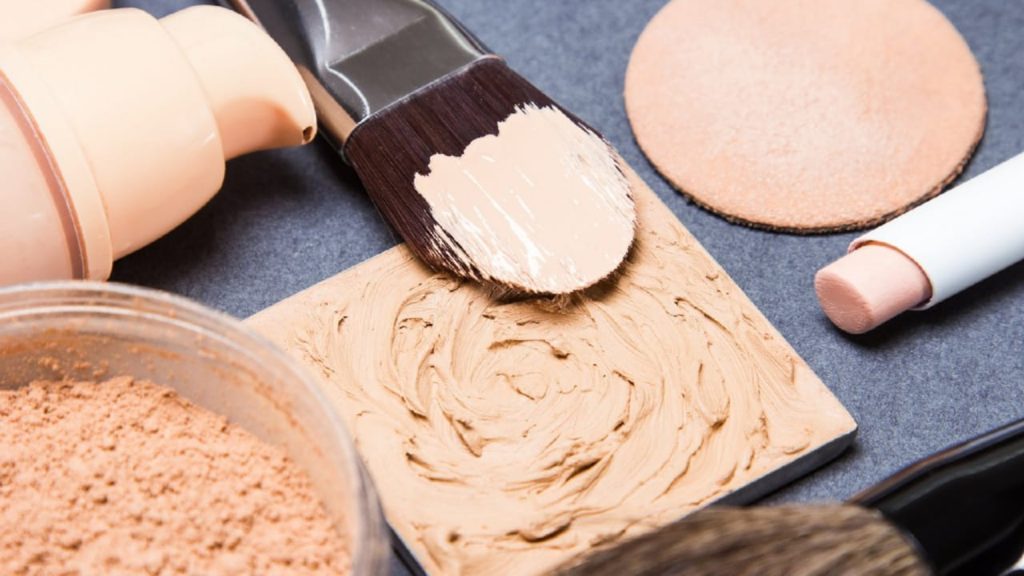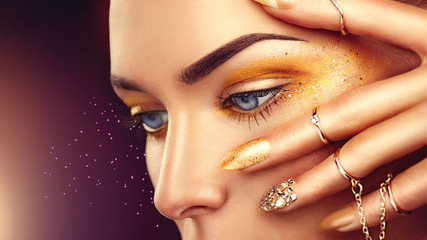Choosing makeup that matches your skin tone can greatly improve the overall appearance of your skin and help you achieve the desired effect. For example, the wrong foundation or powder can make your skin look pale, gray, or too pink. Therefore, it is important to understand your skin tone and choose the makeup that matches it most closely.
As a rule, powder comes in three different shades: pink, neutral and beige.
Pink undertones are cool and have a bluish or reddish hue. They work well for people with fair skin and help even out redness or pale skin.
Neutral halftones are a mixture of warm and cool tones and are suitable for people of all skin tones. They help balance the skin and create a natural, smooth look.
Beige tones are warm, with a yellow or golden hue. They work well for people with medium to tan skin and help warm up the complexion and create a healthy, radiant look. Choosing the right subtone powder can help accentuate your natural skin tone and create a more flawless, polished finish.
Choosing a powder
The task before the buyer is not an easy one: because there are many types of this cosmetic product, both in texture and tone, and each has its own pros and cons. It is worth knowing at least the main characteristics of each.
- The compact version is preferred by many women. It is convenient to carry in a cosmetic bag – it is stored in a powder case and if necessary to apply to the surface of the skin at the right moment – there is a mirror and a brush. A distinctive feature is the presence of an increased amount of fats among the ingredients of the compact fragrance powder, which makes it useful for dry type of derma.
- It’s easy to even out face tone and quickly hide obvious skin flaws with the help of cream powder. Suitable for normal and dry skin types. Minus – to learn how to apply an even and natural makeup, you need to thoroughly train your hand.
- The peculiarity of powder is its ability to be perfectly combined with foundations and to lie evenly on the skin. A disadvantage is that it is difficult to carry in a purse.
- A very popular powders, or mosaic powders, make the skin smooth and velvety. The balls can be selected in such a way that the question of how to choose a face powder by tone will be closed: for a lighter shade, darker balls are simply removed and vice versa. Disadvantages – it does not get rid of greasy shine; it is inconvenient to carry in a cosmetic bag.
- A universal cosmetic is aqua powder. It helps to hide some skin imperfections. Thanks to its unique composition perfectly nourishes and moisturizes the epidermis. It is convenient to use as a base for makeup.
- A relative newcomer is the mineral powder. Its base consists of mineral particles that allow the skin to breathe and not bad masking and matting it.
- If your skin does not have noticeable imperfections, then the powder on the foundation is perfect for making it soft and even tone. It can be easily applied with a sponge and distributed evenly. It does not form lumps in expression lines.
This type of powder as antiseptic contains antibacterial additives, so it has a therapeutic effect.
Naturally, this type of powder is not suitable for daily use, but only when there are rashes or irritation.
- To disguise the acne will help green powder. It is applied only to the problem areas, and on top – the usual.
- The composition of the terracotta powder includes healing mud. Such a tool is recommended for tanned and swarthy girls. It can also be used to correct the contours of the face instead of blush.

How do I understand my undertones?
Understanding your undertones can help you choose makeup products that complement your natural skin tone and create a flawless, polished finish.
Here are some tips to help you determine your undertones:
- Look at your veins: Check the veins on the inside of your wrist. If they appear blue or purple, you probably have a cold undertone. If they appear green, you probably have a warm undertone. If they look blue-green, you probably have neutral tones.
- Consider your natural skin tone: look at your natural skin tone when you’re not wearing makeup. If your skin has a pink or blush hue, you probably have cool tones. If your skin has a yellow or golden hue, you probably have warm tones. If your skin looks balanced, you probably have a neutral tone.
- Try on different colors: Experiment with different colors of clothing and makeup to see which ones suit you best. Cold skin tones look best in precious tones such as emerald green or sapphire blue. Warm tones look best in earth tones such as olive green or burnt orange. Neutral shades can go with a wide range of colors.
- Consider your reaction to the sun: Pay attention to how your skin reacts to the sun. If you tan easily and struggle to tan, you probably have a cool skin tone. If you tan easily and rarely tan, you probably have warm skin tones. If you tan slowly and can get sunburned, you probably have a neutral skin tone.
Using these tips, you will be able to identify your subtone and choose makeup products that will match your natural skin tone and enhance your appearance.
Determining your subtone is crucial when choosing the right shade of powder, as it helps ensure that your makeup looks organic and natural on your skin. Using a powder with the wrong undertone can make your skin look dull, ashy or too warm.
For example, if you have a cold undertone and you use a powder with a warm undertone, it can make your skin look orange or too yellow. On the other hand, if you have a warm undertone and you use a powder with a cool undertone, it can make your skin look gray or ashy.
By choosing a powder with the right undertone, you can create a more balanced and even skin tone, accentuate your natural features and create flawless coverage. In addition, using a powder that matches your subtone will help you avoid having to use other products to correct your color or neutralize any discoloration in your skin.
Classifying by Tone
Subtones are the subtle tones that lie beneath the surface of the skin. They can be categorized as warm, cool or neutral, and are usually determined by the amount of melanin in your skin and vein tones.
Skin tone, on the other hand, refers to the overall color of your skin, including any blemishes, freckles or discoloration. It is usually classified as light, light, medium, tan or deep.
While skin tone is often used to determine which makeup shades will work best for you, understanding its subtone is just as important. The right makeup tint can help accentuate your natural skin tone and create a more seamless, polished look.
To understand how to choose the right tone of powder for the face, it is necessary to get acquainted with the classification of this cosmetic product exactly by tone.
- To create a bright evening or festive and festive makeup, it is appropriate to use a shimmering (pearlescent) powder. Thanks to the reflective grains in its composition, this powder makes your skin look mysteriously radiant and fresh.
- If nature has awarded you a perfect skin tone, if it does not have defects such as blackheads or age spots, you can afford a colorless powder.
- The matte type is recommended for combination and oily skin. Already its very name says that it is able to mask the shine from grease on the skin and make it matte. Such a product is very convenient to use in the summer heat, when the face gets shiny from sweat.
- The bronzer is similar in appearance to the terracotta compact powder. It seems to “depict” an artificial tan, so it is more logical to use it in summer to enhance the effect. It is not recommended to use it on the pale skin. It should be applied in a very thin layer.
- As a rule, the transparent powder is combined with another type and more often – creating a professional makeup. Its undoubted advantage is to make the face smooth and fresh. It is not recommended for dark-skinned people.
What color is right for you?
To ensure that your skin has a natural tone under a layer of fragrant cosmetic powder, you need to know how to choose the right color of powder for your face. According to the recommendations, it is applied over foundation, so it is ideal that both these products match in tone, and even better – were from the same manufacturer.If the powder is applied without foundation, it is necessary to choose the tone that is closest in color to the skin.
When choosing a product, you should take into account some points, in particular the color type of the dermis. It can be neutral, cold and warm. How to determine your color type? It’s not difficult. It is necessary in natural daylight to consider the thin veins on the wrist – they are clearly visible through the delicate skin. If they have a slightly greenish hue, then we can talk about a warm color type, if blue – the cold.
The face of a warm color type will look more advantageous using bronze and terracotta, gold and copper, yellow and peach shades.
The cold type involves the choice of grayish and white, silvery and bluish tones.
Any shade will suit a neutral shade, but lilac, pinkish-purple and cranberry are the most preferable.
How to match the powder to your complexion? The easiest way is to apply a small amount of cosmetic powder or creamy substance on a small area on your face and compare it to the color of your skin.It is also necessary to remember that if this cosmetic is chosen correctly, it should match not only the color of your hands and neck, but also with the color of your hair and clothing.
You should also take into account a few more points.
- The brown shades of powder are able to emphasize the tan obtained in a tanning salon or on the beach.
- To dark-skinned women it is better to use a bronzer.
- Pink colors are dangerous on non-tanned skin: they will give it an unnatural appearance.
- Pink colors make the face look fuller.
- A bronze shade can add age and also elongates the face.
- Shades of marble or ivory will give the face a noble color.



